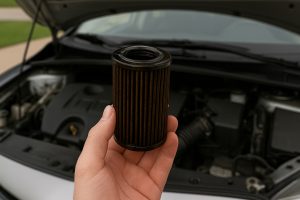An oil filter is one of the smallest and most inexpensive components in your car’s engine system — but it plays a massive role in keeping the engine alive and running smoothly. Unfortunately, many drivers neglect this critical part until something goes wrong.
A dirty or clogged oil filter doesn’t just reduce performance — it can ruin your engine, leading to overheating, internal wear, and complete breakdown. In this guide, we’ll explore how dirty oil filters cause damage, the warning signs to look out for, and the steps you can take to avoid costly repairs.
The Role of the Oil Filter in Engine Health
Every time your engine runs, the oil inside circulates under pressure to lubricate key components. During this process, the oil collects dirt, carbon deposits, microscopic metal shavings, and other contaminants.
Your oil filter’s job is to trap those particles and prevent them from circulating back into the engine. Without proper filtration, dirty oil can grind away at engine parts, clog passages, and cause significant mechanical damage.
How Dirty Oil Filters Damage Engines

Over time, an oil filter becomes saturated with contaminants. If not replaced, it can cause the following problems:
1. Restricted Oil Flow
A clogged oil filter reduces the amount of oil that reaches the engine, starving it of lubrication.
| Effect on Engine | Description |
|---|---|
| Friction increases | Parts grind together due to lack of oil |
| Overheating | Oil helps carry away engine heat |
| Rapid wear | Bearings, pistons, and cams degrade faster |
2. Unfiltered Oil Circulation
When pressure builds up due to a blocked filter, most filters activate a bypass valve, allowing oil to continue circulating—without being filtered.
| Problem | Result |
|---|---|
| Contaminants in oil | Accelerated engine wear |
| Sludge build-up | Internal blockages |
| Oil degradation | Shortened oil life cycle |
3. Oil Pressure Drops or Spikes
Unstable oil pressure due to a blocked or malfunctioning filter can damage seals, gaskets, and oil pumps.
Common Signs of a Dirty Oil Filter
Watch for these red flags indicating your oil filter might be overdue for a change:
| Symptom | Possible Cause |
|---|---|
| Check Engine or Oil Light | Low pressure or clogged filter |
| Engine overheating | Inadequate oil circulation |
| Metallic ticking sounds | Dry-running engine parts |
| Dirty, dark oil | Overloaded filter can’t clean effectively |
| Drop in fuel efficiency | Engine not running optimally |
How Often Should You Replace Your Oil Filter?
This depends on your car, driving conditions, and oil type. But here are general recommendations:
| Vehicle Usage | Recommended Interval |
|---|---|
| Normal (city/highway) | Every 5,000–7,000 km |
| Severe (off-road, short trips, towing) | Every 4,000–5,000 km |
| Using synthetic oil | Every 10,000–15,000 km (with premium filter) |
It’s best practice to change your oil filter with every oil change.
How to Prevent Engine Damage from Dirty Oil Filters
Use Quality Oil Filters
Cheap or off-brand filters may fail faster or offer poor filtration. Choose trusted brands with multi-layered media and anti-drain-back valves.
Stick to a Regular Maintenance Schedule
Use your vehicle manual as a guide and set reminders to replace oil and filters on time.
Match Filter to Oil Type
Use filters designed to match the longevity of your oil — standard filters for conventional oil and high-performance filters for synthetic oil.
Watch for Symptoms
Don’t ignore warning signs like engine noise, poor acceleration, or dashboard lights.
Keep an Eye on Oil Condition
Check your dipstick every few weeks. If the oil looks thick, sludgy, or unusually dark, the filter may be saturated.
Oil Filter Types and Their Performance
| Filter Type | Lifespan | Best For |
|---|---|---|
| Standard cellulose | 5,000–7,000 km | Daily drivers with conventional oil |
| Synthetic blend | 10,000 km | Light trucks, mixed driving |
| Micro-glass/synthetic media | 15,000+ km | Long-drain intervals, synthetic oil |
| High-performance racing filters | 3,000–5,000 km | High-RPM or motorsport engines |
Choosing the right filter improves engine efficiency and long-term reliability.
Maintenance Checklist: Avoid Oil Filter Trouble
Here’s a quick reference for staying ahead of oil filter problems:
| Task | Frequency |
|---|---|
| Check oil level and quality | Every 2-3 weeks |
| Change oil and filter | Every 5,000–10,000 km |
| Inspect filter for leaks or damage | Every oil change |
| Use high-quality oil and filters | Every service |
| Keep track of service intervals | With app or sticker |
Final Thoughts

A dirty oil filter is more than just a maintenance nuisance — it’s a ticking time bomb for your engine. What starts as slightly dirty oil can escalate into high repair costs, reduced engine life, or total breakdown.
Replacing your oil filter regularly is simple, cost-effective, and crucial. Combined with quality oil and smart driving habits, it’s one of the best things you can do for your car’s longevity.
Don’t wait for damage to happen. Keep your engine protected and your performance at its peak:
Take care of your filter, and your engine will take care of you.